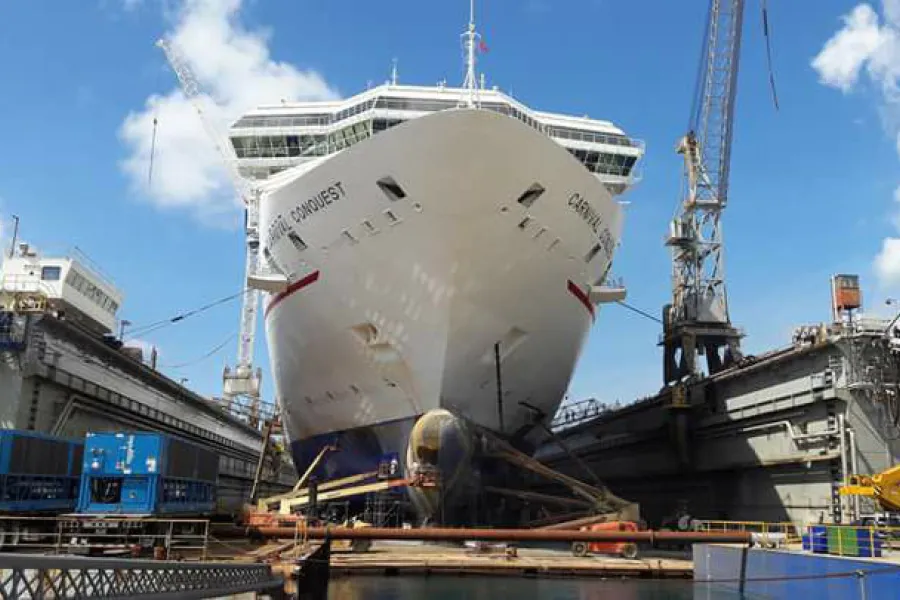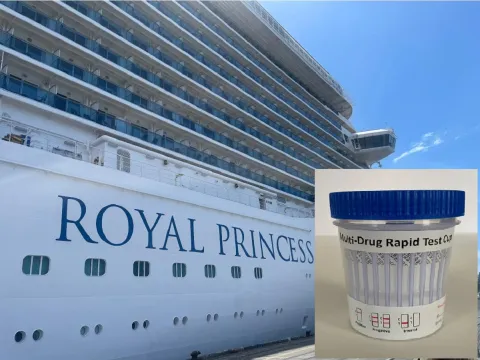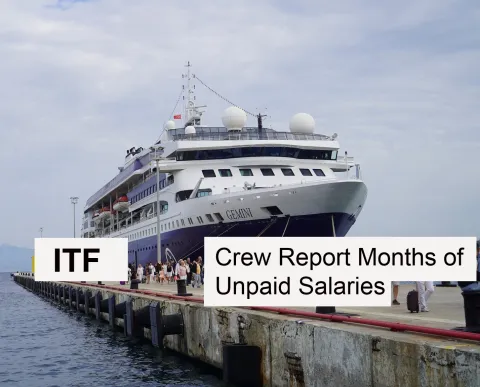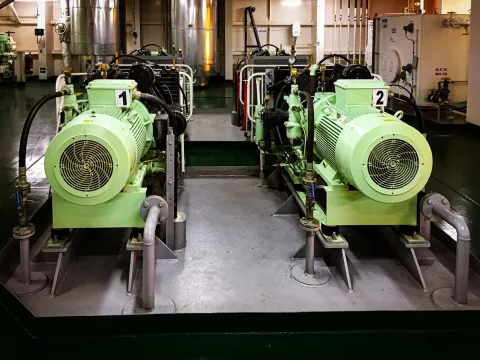
The dry dock is used for vessel construction, maintenance, and repair. It can be filled with water or emptied as required, and most shipyards have one or more dry docks of various sizes to carry out production or other activities. More extensive docks can be used to manufacture and repair massive vessels, such as container or ocean-going cruise ships. The facility is kept free of water to facilitate the work of operators.
The dry dock works by using pumps to fill the interior with water by gravity up to the level of the exterior area. This way, any ship or material can be introduced without any problems. Once the ship is inside, the emptying process begins, and the water is pumped out. The vessel is then placed on the riding surface (bottom, keel, or side) to secure it once the dock is dry, and work on the vessel can begin. To optimally position the dry docks, it is necessary to know the dry-docking plan of the ship, data on the bow and stern draft, displacement, stability conditions, and load distribution.

After any necessary work on the ship or completion of its construction, the dry dock is refilled until the vessel is afloat and the water level is equal to the outside water level. The floodgate is then opened, and the vessel is towed out. With various types of dry docks available, carrying out maintenance and repair tasks in conditions adapted to specific boats is possible. This ensures that the work is carried out satisfactorily and comfortably.

As a seafarer, you know the time and effort required to successfully carry out a dry docking procedure. Several maintenance tasks are carried out simultaneously by both ship and shore staff, and various machinery systems are dismantled all around the engine room, and piping systems are opened up for repair jobs. Additionally, several people, from surveyors to shore technicians, visit the ship now and then.
While the ship is in dry dock, depending on the work done, a horde of contractors will come on board to carry out various positions. Restrictions will apply to where you can be onboard the ship, your duties, where you have your meals, etc. While the ship is in dry dock, duty is usually easier than when you have passengers onboard, but it requires a lot of flexibility and often being on call. Since many workers are onboard, more attention must be paid when wandering around the ship. There is welding, electrical work, sanding of the teak floors, and repairs overhead. This results in sparks flying and cables hanging from above. Most cruise lines have briefings with the crew members before the dry dock to point out those hazards and give guidelines and rules on how things work while the ship is in dry dock.

Personally, I found being on the ship during a dry dock to be an exciting journey. Nowadays, most dry docks are done in Freeport, Nassau, because it's much cheaper to do it there, competing with dry docks in US ports. The dry dock is when the ship goes to a specific port for refurbishment, painting, fixing the installation, re-designing guest areas, or servicing the engine. Usually, for crew members, that means being without customers for a specific period, which can last around two weeks, depending on the company and size of the ship.
For crew members, being in dry dock can mean more workload or less work and more fun, depending on their role on the ship. Fitters, plumbers, deck or engine staff members, for example, will have much additional work without extra pay, whereas dining room or bar department members may have some spare time off the ship. I remember being fortunate enough to be on dry dock in San Francisco for two weeks.
Story from the dry dock
Nowadays, most dry docks are done in Freeport, Nassau, because it's much cheaper to do it there, competing to dry dock in US ports. The dry dock is when the ship goes to a specific port for refurbishment, painting, fixing the installation, re-designing guest areas, or servicing the engine. Usually, for the crew members, that means being without customers for a specific period. Mostly, the Dry dock lasts around two weeks, depending on the company and size of the ship. For the crew members, it could be a fun time. Depending on your role on the ship, it can mean more workload or less work and more fun. If you are a fitter, plumber, deck, or engine staff member, there will be much additional work( without extra pay).

On the other hand, if you are a dining room or bar department member, that could mean some spare time off outside of the ship. I remember being fortunate to be on the Dry dock in San Francisco for two weeks. During the Dry dock, most of the bar staff was allocated to do some jobs in the ship bars, deep cleaning the fridges, scrubbing the floors, and inventorying all bar items. Yet, I was not working with the bar department during the dry dock.

The Bar manager asked one volunteer to join the Engine team during the Dry Dock stay. Most bar staff members were skeptical; they probably thought it would be a lot of work in the engine control room, cleaning, and who knows what else. I took a risk and signed up voluntarily to be in the engine department during those two weeks on the Dry dock in San Francisco. It was one of the best decisions of my lifetime. On the first day during the dry dock, I arrived precisely at 0700. When I arrived, the chief engineer told me to bring coffee to all engine workers. It took me 15 minutes and go to the coffee shop and get the coffee for them. At 0715, when I came back, the chief engineer told me," You can go, come back tomorrow at the same time. We needed somebody from the bar department to bring us coffee in the morning. Come back tomorrow at 07 am." Wow. How lucky I was on that day! I had the best job in the world during those two weeks in San Francisco. I was free like a bird; I could explore San Francisco up and down, go to the Golden Gate Bridge, visit Alcatraz State Prison, and then go in the night to hit some of the famous nightclubs in San Francisco.
Most of my colleagues from the bar department were visibly jealous of me because there were working hard every day in the bar; deep cleaning was never ending job. For instance, in the bar department, each person was getting paid $15 per day during the Dry dock because we had no guests on the ship simultaneously. For myself, because I signed up to be part of the Engine department, I was getting paid $55 per day to bring one round of coffee from 07 am until 07:15! After that, I was free to get off the ship and return as many times as I wanted in 24 hours. Plus, I was getting paid for it; I had a free, paid vacation in one of the most beautiful cities in the world. Whenever I would pass by on the ship and meet my fellow bar department colleagues, they would be all jealous because they needed deep cleaning in the bars daily; they had to earn their chance to get off the ship. After bringing the coffee to the engine officers, at 0715, I would run to my cabin to change my clothes and straight down to the Gangway. I would grab some coffee outside and walk around San Francisco. On the first night of our Dry Dock, there was a concert by one of my favorite DJs, Carl Cox, and I enjoyed the show so much. That night, I stayed outside in San Francisco until 06 am and returned to the ship just in time to get ready for my job( 15 minutes of coffee service) in the Engine room. Indeed, that was the time of my life.
Crew Insights
Articles and experiences shared by crew members working on cruise ship. Find out more about ship life at sea together with tips and advices for first time crew members and cruise oldtimers.












